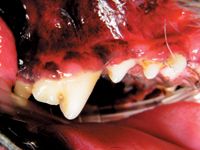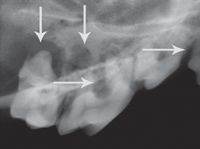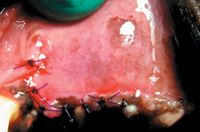The perils of anesthesia-free dentistry in pets
Nonprofessional dental scaling misses serious disease below the gum line and can damage teeth.
Anesthesia-free dentistry, or nonprofessional dental scaling (NPDS), is becoming more common, particularly in dogs and cats. Anesthetic concerns, monetary issues and the desire to maximize the health and welfare of a beloved pet by providing some form of dental care all play a role in the onset and proliferation of this practice. But are we helping, hurting or working somewhere in between when we clean pets' teeth without adequate anesthesia?
Case example 1: A history of inadequate care
To avoid administering general anesthesia in a 10-year-old dog, at the client's request, the choice was made to provide regular dental cleaning with hand curettes and polishing on the awake patient. Although this dog also received excellent homecare, including brushing daily, profound disease below the gum line was the disastrous result of failing to undergo a thorough dental examination and cleaning that would have required anesthesia (Photos 1 and 2).

Photo 1: This 10-year-old patient has undergone several sessions of anesthesia-free dental cleaning.
Numerous ineffective cleaning procedures were performed on this patient, but the end result was still multiple extractions for dental disease that should have been addressed years earlier. The remainder of this patient's oral cavity had similar pathology. This case is, unfortunately, the rule and not the exception.

Photo 2: A radiograph of the region shows profound stage 3 and 4 periodontal disease as evidenced by the arrows at the apical extent of bone destruction.
Case example 2: Disease that could be missed
A second patient represents a situation that is commonly missed if anesthesia-free dentistry is performed. This middle-aged dachshund has an oronasal fistula due to periodontal disease associated with the loss of the maxillary right fourth premolar (104). Improper closure resulted in a defect exposing the nasal cavity (Photo 3). The opposite canine tooth (204) demonstrates no visible pathology (Photo 4); however, a periodontal probe placed on the palatal aspect of this tooth reveals an 8-mm periodontal pocket where bone has been destroyed. In time, this will result in a similar outcome.

Photo 3: This patient has an oronasal fistula that was created when tooth extraction was not followed by proper closure of the defect. The arrow points to the exposed nasal mucosa.
Since anesthesia-free dentistry does not allow for probing or thorough examination, this finding would have been missed. Because of the client's inability to brush this patient's teeth, the tooth was extracted rather than trying to grow new attachment with periodontal regenerative therapy (Photo 5).

Photo 4: The opposite tooth in the same patient looks to be relatively normal. However, probing reveals an 8-mm pocket that is close to producing a similar fistula.
The importance of complete dental care
Concerns about anesthesia are issues within both the human and veterinary medical fields. Oral surgical procedures may be extended and rather involved, and, consequently, they require adequate preanesthetic, intraoperative and postoperative management of all vital parameters affecting patients. Veterinary practices that routinely perform dental radiography and probing on all dental patients practice at an advanced level of care. They're also likely to be well-equipped to safely monitor patients and handle any problems they encounter.

Photo 5: Anesthesia-free cleaning will provide a false sense of security in cases such as this. The palatal side of the teeth cannot be cleaned properly nor can the extent of the bone damage be assessed without anesthesia. The end result is extraction and proper closure to eliminate the inevitable fistula.
Administration of premedications and nerve blocks enables patients to be kept at anesthetic depths consistent with that of a light general anesthesia. This keeps patients close to waking, even when extractions or other invasive procedures are needed, thus maximizing cardiac output and tissue perfusion and maintaining blood pressure.
Conclusion
As illustrated below, NPDS is a cosmetic-only procedure. It hides the true disease that exists below the gum line. It also can be damaging to the tooth and the patient. The American Veterinary Dental College (AVDC) has released a position on the practice of NPDS (see sidebar).
The best advice is to continue to practice high-quality diagnostic dentistry to ensure your patients have the best oral care available.

AVDC Position Statement on NDPS
The next installment of this series will uncover problems missed with improper evaluation of oral disease during in-hospital cleaning.
Dr. Beckman is acting president of the American Veterinary Dental Society and owns and operates a companion-animal and referral dentistry and oral surgery practice in Punta Gorda, Fla. He sees referrals at Affiliated Veterinary Specialists in Orlando and at Georgia Veterinary Specialists in Atlanta, lectures internationally and operates the Veterinary Dental Education Center in Punta Gorda.